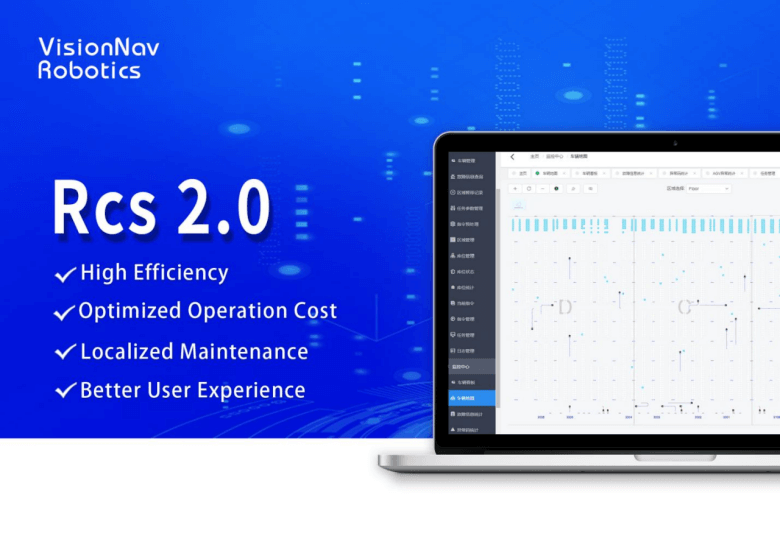
The Robot Control System (RCS) is introduced and self-developed by VisionNav Robotics, a global supplier of autonomous forklifts. The system can be used as a management system that seamlessly connects MES, WMS, ERP, and other customer systems, meanwhile, connects autonomous forklifts equipped with visual navigation modules, thus achieving multi-vehicle and cross-scenario scheduling.
RCS 2.0 version maintains the convenience and practicability of the original one and is leveled up with more functions. In terms of performance, it has stronger scalability, and realizes the compatible scheduling of multiple models in different scenarios, including AGVs, latent jacking robots, four-way shuttle vehicles, and other models; in terms of efficiency, the operation efficiency has doubled without paying more; at the same time, the interface adopts refreshed UI, thus to bring users a better working experience.
Intelligent Algorithm Upgrading Brings Improvement Efficiency
With the acceleration and deepening of the automation of manufacturing logistics and warehousing logistics, autonomous forklifts will cope with more complex operation scenarios, and multi-vehicle coordination and schedule planning of autonomous forklifts. The difficulty will increase as the scale of the cluster is growing larger.
Relying on the upgrade of the algorithm, the RCS 2.0 version adopts the whole-situation path calculation and the real-time planning of the single-vehicle path in the large-scale cluster scheduling process of the autonomous forklift. Prevent lockups, traffic jams, and long-holding among vehicles.
The VisionNav RCS 2.0 has been applied to many customer projects. According to the on-site feedback of some customers' projects in the multi-vehicle mixed-running scenario, the comprehensive operation efficiency increased by 10% during the peak period of business volume.
Error-dealing Mechanism Helps Save Operation Costs
RCS 2.0 provides a more complete vehicle exception handling mechanism, adding functions such as task transfer and abnormal vehicle avoidance.
If there is no avoidable path, the system will perform cascade avoidance processing on vehicles that cannot be avoided, that is, if a vehicle fails, the system will re-plan vehicles b and c that need to pass through point a, of which vehicle b can be avoided. While car c cannot be avoided in the process, the system will continue to make obstacle avoidance planning for cars e, f, and g that need to pass through car point c, and so on. Cascading avoidance can improve the efficiency of avoiding obstacles. The more vehicles there are, the more obvious the efficiency improvement will be.
RCS 2.0 version effectively reduces the losses caused by task delays and channel blockages caused by abnormal conditions of autonomous forklifts and minimizes operating costs.
New Functions Bring Better User Experience
RCS 1.0 version supports vehicle management, storage location management, order management, task management, and other functions. RCS 2.0 version upgrades and expands on this basis, and adds more sub-functions such as storage location statistics and fault information query.
In addition, the RCS 2.0 version of the operation interface adopts a new VI, the interface display is more concise and intuitive, and it can be understood at a glance, which enhances the user interaction experience.
Multi-language Support, Localization Maintenance
The language of the RCS 2.0 version has been expanded from supporting Chinese and English bilinguals to supporting Chinese, English, Japanese, Korean, and other multi-language operations. With the country/region where the project is located, the language system can be switched with one click, and at the same time, it supports localized system maintenance to ensure the remote control of the project. Easier to deliver.
VisionNav RCS 2.0 system will continue to be iteratively upgraded. With stronger performance, smarter algorithms, easier use, and openness, it will help customers reduce costs and increase efficiency, and realize the evolution within intralogistics under full scenarios.
VisionNav Robotics
VisionNav® Robotics is a leading global supplier of autonomous industrial vehicles and intralogistics automation solutions. Based on the 5G Communication, Perception, Deep Learning, and Servo Control technology, VisionNav has developed 9 product series for full-stack scenarios. By now VisionNav has served more than 30 countries and deployed 200+ projects around the globe, and reached cooperations with 50+ Fortune 500 companies, covering auto manufacturing, tire, food, petrochemical, e-commerce, 3PL, pharmaceutical, and other industries.
Media Relations
xchen@visionnav.com